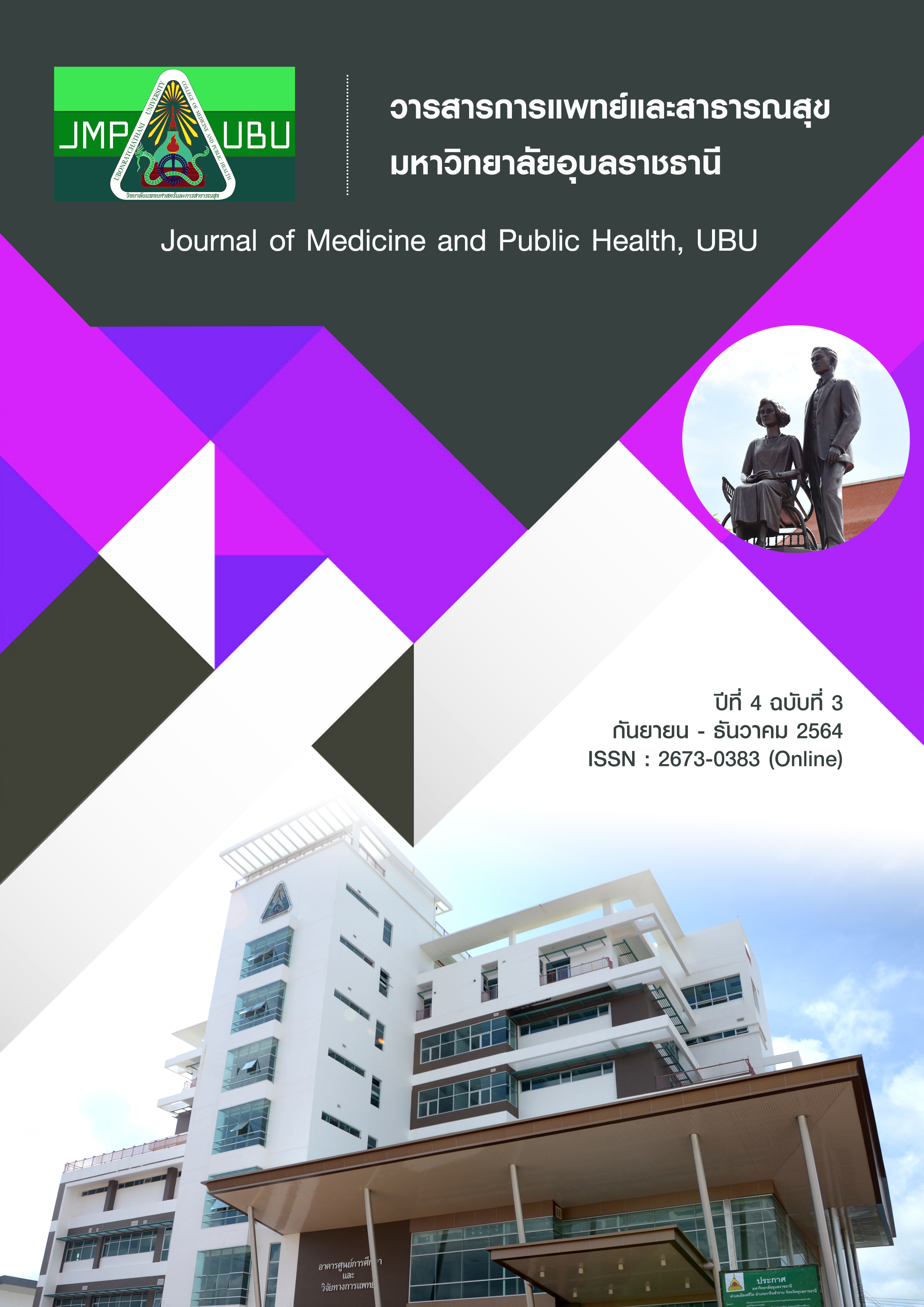ความสัมพันธ์ระหว่างความรู้ ทัศนคติ และพฤติกรรมการแยกทิ้งของเสียอันตรายในห้องปฏิบัติการ ของนิสิตคณะสาธารณสุขศาสตร์ มหาวิทยาลัยพะเยา
คำสำคัญ:
ความรู้, ทัศนคติ, พฤติกรรม, ของเสียอันตราย, ความปลอดภัยบทคัดย่อ
การศึกษาครั้งนี้มีวัตถุประสงค์เพื่อศึกษาความสัมพันธ์ของความรู้ ทัศนคติ และพฤติกรรมในการแยกทิ้งของเสียอันตรายในห้องปฏิบัติการของนิสิตคณะสาธารณสุขศาสตร์ มหาวิทยาลัยพะเยา กลุ่มตัวอย่าง คือ นิสิตที่เรียนรายวิชาการวิเคราะห์น้ำและน้ำเสีย จำนวน 45 คน เก็บรวบรวมข้อมูลโดยใช้แบบสอบถาม วิเคราะห์ข้อมูลด้วยสถิติเชิงพรรณนา และสถิติสัมประสิทธิ์สหสัมพันธ์ของเพียร์สัน (Pearson’s correlation) ที่ระดับนัยสำคัญ 0.05 ผลการศึกษา พบว่า กลุ่มตัวอย่างส่วนใหญ่เป็นเพศหญิง (93.3%) อายุเฉลี่ย 21 ปี เกรดเฉลี่ยสะสม (GPA) 2.61±0.81 ไม่เคยเข้าอบรมหรือเรียนเรื่องการแยกทิ้งของเสียอันตราย (80.0%) มีค่าเฉลี่ยและส่วนเบี่ยงเบนมาตรฐานของคะแนนความรู้ ทัศนคติ และพฤติกรรมในการแยกทิ้งของเสียอันตรายอยู่ในระดับสูง เท่ากับ 10.4±3.0, 20.7±0.7 และ 23.2±3.3 ตามลำดับ เมื่อจำแนกตามระดับความรู้ ทัศนคติ และพฤติกรรมการแยกทิ้งของเสียอันตราย กลุ่มตัวอย่างบางคนมีระดับความรู้ต่ำ ร้อยละ 4.4 มีระดับทัศนคติและพฤติกรรมการแยกทิ้งของเสียอันตรายอยู่ในระดับปานกลาง ร้อยละ 2.2 และ 48.9 ตามลำดับ คะแนนความรู้มีความสัมพันธ์กับทัศนคติของการแยกทิ้งของเสียอันตรายอย่างมีนัยสำคัญทางสถิติ (r = 0.305, p-value = 0.042) คะแนนทัศนคติมีความสัมพันธ์กับพฤติกรรมในการแยกทิ้งของเสียอันตราอย่างมีนัยสำคัญทางสถิติ (r = 0.355, p-value = 0.017) ดังนั้น ก่อนจัดการเรียนการสอนที่มีการใช้สารเคมี นิสิตควรมีความรู้เกี่ยวกับการแยกทิ้งของเสียอันตรายในห้องปฏิบัติการ และควรส่งเสริมทัศนคติที่ดีเกี่ยวกับการแยกทิ้งของเสียอันตรายให้กับนิสิต เพื่อให้มีการแยกทิ้งของเสียอันตรายได้อย่างถูกต้อง
Downloads
เอกสารอ้างอิง
วิษณุพงษ์ ห้วยกรดวัฒนา, พัชรา สินลอยมา. แนวทางการพัฒนาการจัดการของเสียอันตรายจากห้องปฏิบัติการทางวิทยาศาสตร์. วารสารวิชาการบัณฑิตวิทยาลัยสวนดุสิต 2563; 16(3): 127-142.
กรมควบคุมมลพิษ. คู่มือการจัดการของเสียของห้อง ปฏิบัติการอนามัยสิ่งแวดล้อม [อินเตอร์เน็ต]. [สืบค้น เมื่อ 5 ตุลาคม 2564]. แหล่งข้อมูล: http://infofile.pcd.go.th/ptech/Envilabwast.pdf?CFID=1236729&CFTOKEN=52902108.
โครงการยกระดับมาตรฐานความปลอดภัยห้องปฏิบัติการวิจัยในประเทศไทย Enhancement of Safety Practice of Research Laboratory in Thailand “ESPReL”. คู่มือการประเมินความปลอดภัยห้องปฏิบัติการ ฉบับแก้ไขเพิ่มเติม ครั้งที่ 2 Lab Safety Inspection Manual, Second Edition [อินเตอร์เน็ต]. [สืบค้น เมื่อ 5 ตุลาคม 2564]. แหล่งข้อมูล: http://esprel.labsafety.nrct.go.th/files/ESPReL-Book2.pdf.
วรวดี วรภัทร์ และธณินี วงศ์อกนิษฐ์. ฐานข้อมูล ความปลอดภัยสารเคมี คณะวิทยาศาสตร์และเทคโนโลยี มหาวิทยาลัยสวนดุสิต [อินเตอร์เน็ต]. [สืบค้นเมื่อ 8 ตุลาคม 2564]. แหล่งข้อมูล: http://ohs.sci.dusit.ac.th/wp/?p=2045
จุฬาลงกรณ์มหาวิทยาลัยและกรมโรงงานอุตสาหกรรม. เอกสารข้อมูลความปลอดภัย. [อินเตอร์เน็ต]. [สืบค้น เมื่อ 2 ตุลาคม 2564]. แหล่งข้อมูล: https://www.tailiang.co.th/MSDS/MSDS_Copper(II)Sulfate.pdf
Bloom BS. Handbook on formative and summative evaluation of student learning. New York: McGraw–Hill; 1971.
Best JW. Research in Education. New Jersey: Prentice Hill: 1983.
Rovinelli RJ, Hambleton RK. On the use of content specialists in the assessment of criterion-referenced test item validity. Dutch Journal of Educational Research 1977; 2: 49-60.
Cronbach LJ. Essentials of Psychological Testing. New York: Harper and Row Publishers; 1970. 752.
ปราณี แซ่เจ็ง, อิสรีย์ ขันทอง. การศึกษาการรับรู้ความปลอดภัยและพฤติกรรมความปลอดภัยในห้องปฏิบัติการวิทยาศาสตร์มหาวิทยาลัยราชภัฏธนบุรี [อินเตอร์เน็ต]. [สืบค้น เมื่อ 15 กุมภาพันธ์ 2564]. แหล่งข้อมูล:http://cms.dru.ac.th/jspui/handle/123456789/1480
วันวิสาข์ คงพิรุณ, สรัญญา ถี่ป้อม, วิโรจน์ จันทร. ปัจจัยที่มีผลต่อพฤติกรรมการจัดการขยะในหมู่บ้านโป่งปะ ตําบลแก่งโสภา อําเภอวังทอง จังหวัดพิษณุโลก.วารสารวิชาการสาธารณสุข 2560; 26(2): 310-321.
สุวัฒน์ ศิวาคม. การศึกษาประสิทธิผลของคู่มือความปลอดภัยในห้องปฏิบัติการเคมี วิทยานิพนธ์วิทยาศาสตรมหาบัณฑิต (การจัดการสิ่งแวดล้อม). ภาควิชาการจัดการสิ่งแวดล้อม, คณะพัฒนาสังคมและสิ่งแวดล้อม. กรุงเทพมหานคร: สถาบันบัณฑิตพัฒนบริหารศาสตร์; 2553.
ดาวน์โหลด
เผยแพร่แล้ว
รูปแบบการอ้างอิง
ฉบับ
ประเภทบทความ
สัญญาอนุญาต
เนื้อหาและข้อมูลในบทความที่ลงตีพิมพ์ในวารสารการแพทย์และสาธารณสุข มหาวิทยาลัยอุบลราชธานี ถือเป็นข้อคิดเห็นและความรับผิดชอบของผู้เขียนบทความโดยตรง ซึ่งกองบรรณาธิการวารสารไม่จำเป็นต้องเห็นด้วย หรือร่วมรับผิดชอบใด ๆ
บทความ ข้อมูล เนื้อหา รูปภาพ ฯลฯ ที่ได้รับการตีพิมพ์ในวารสารการแพทย์และสาธารณสุข มหาวิทยาลัยอุบลราชธานี ถือเป็นลิขสิทธิ์ของวารสารการแพทย์และสาธารณสุข มหาวิทยาลัยอุบลราชธานี กองบรรณาธิการไม่สงวนสิทธิ์ในการคัดลอกเพื่อการพัฒนางานด้านวิชาการ แต่ต้องได้รับการอ้างอิงที่ถูกต้องเหมาะสม






